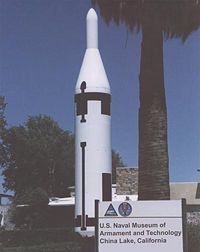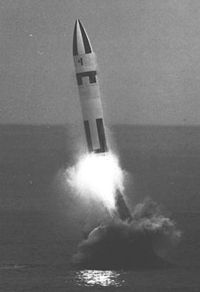UGM-27 Polaris
UGM-27 Polaris submarine-launched ballistic missiles were the first SLBMs in operational use. Previously, submarine-launched missiles, for the U.S. and Soviet Union, were an early equivalent of cruise missiles. The submarine had to surface to launch them, making the vehicle vulnerable to attack. Polaris could be launched from a submerged submarine.
While an intermediate range ballistic missile, the Polaris was signficantly smaller than its land-based cousins, the Air Force PGM-17 Thor and Army PGM-19 Jupiter. Britain also used Polaris missiles aboard its Resolution-class submarines; the British variants, which stayed in service longer than the American ones, had "B" rather than "A" suffixes.
The program was managed with great success by Rear Admiral "Red" Raborn, a brilliant engineering manager who was later to be a misfit as Director of Central Intelligence. Captain Levering Smith was technical director.
Deployment
The first version, Polaris A1, was test-fired on July 20, 1960. Aboard the USS George Washington, the lead boat of the first U.S. ballistic missile submarine, began its first operational patrol on November 15, 1960. George Washington class boats were adaptations of production attack submarines, which were cut in half and the missile section welded between the two halves.
First test-launched from a submerged submarine on 23 October 1961, the A2 version, which was slightly longer than the A1 but had numerous improvements giving it 1500 mile range, became operational on June 26, 1962. The A2 was aboard the USS Ethan Allan, which was the first ballistic submarine constructed completely for that mission.
Polaris A3 was a significant enhancement, with 2500 mile range and multiple warheads. It was test fired on August 7, 1962. Its operational deployment started on September 28, 1964, aboard the USS Daniel Webster'.
Warhead
In its first two versions, Polaris used various modifications of the W47. While this warhead was a leap forward in miniaturization, it was also unreliable and required significant remanufacturing; no more than 300 were ever serviceable. The Y1 version had a 600 kt and the Y2 a 1.2 Mt yield. One of the miniaturization advances was that the reentry vehicle and beryllium reflector were one physical assembly.
The Polaris A3 changed to a multiple reentry vehicle system with three W58 warheads.
Missile versions
While it was eventually replaced by the UGM-73 Poseidon, there were three versions of the missile. All used solid propellant rocket engines, which were a fortuitous development of Navy-funded basic chemistry research that developed nitropolymers, the fuel component of the solid rocket. The oxidizer was ammonium perchlorate, with additional energy provided by aluminium powder.
Polaris A1
The first version, delivered in the amazingly short time of four years from contract award, had two stages, with "jetevator" attitude control fins in the exhaust. Both were made of steel.
It had relatively inaccurate inertial guidance ,designed by MIT, manufactured by General Electric and Hughes) guided the missile to an accuracy of about 900 m (3000 ft) CEP at a maximum range of 2200 km (1200 nm). This poor accuracy, coupled with a relatively low-yield W-47 (600 kT) thermonuclear warhead, made the Polaris unsuitable for strikes against hardened strategic targets. However, because the SLBM force could not effectively taken out by the enemy, it was the ideal retaliation weapon, and therefore very important for the Cold War concept of MAD (Mutually Assured Destruction).
Polaris A2
A2 versions were longer, making use of the full length of the launching tube. It had a lighter fiberglass second stage, improving the range to 2800 km (1500 nm), the performance originally envisioned by the Navy. The A-2 also had new electronics for higher reliability, although there continued to be warhead reliability problems. [1]
There was a new second-stage motor, replacing the nitropolymer fuel with a double-base propellant that contained aluminium and ammonium perchlorate. It replaced the jetevators with four-nozzle thrust vectoring.[2]
Polaris A3
In the final A3 version, the Navy was able to incorporate changes that had been desired, but that there had been no time to implement. Both stages had fiberglass bodies and the guidance section weight was reduced by 60%. The first stage engine was completely new, built by Hercules, with an increased energy propellent and fluid injection thrust vectoring not needing the weight of separate nozzles. Together, these increased range to 4600 km (2500 nm).
It had three separate 200 kt W58 warheads, with individual CEP of 600m/2000 ft.
References
- ↑ Andreas Parsch, Lockheed UGM-27 Polaris, Designation Systems
- ↑ Polaris A2, Globalsecurity

